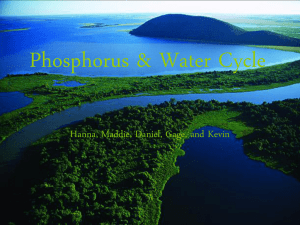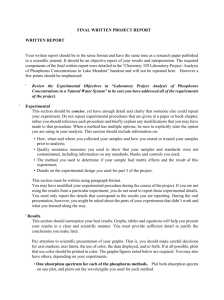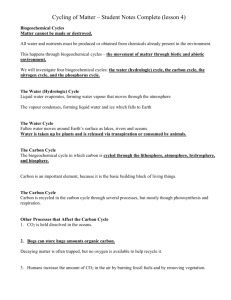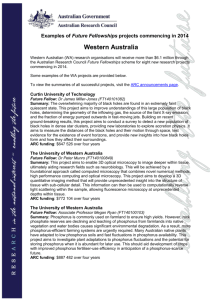here
advertisement
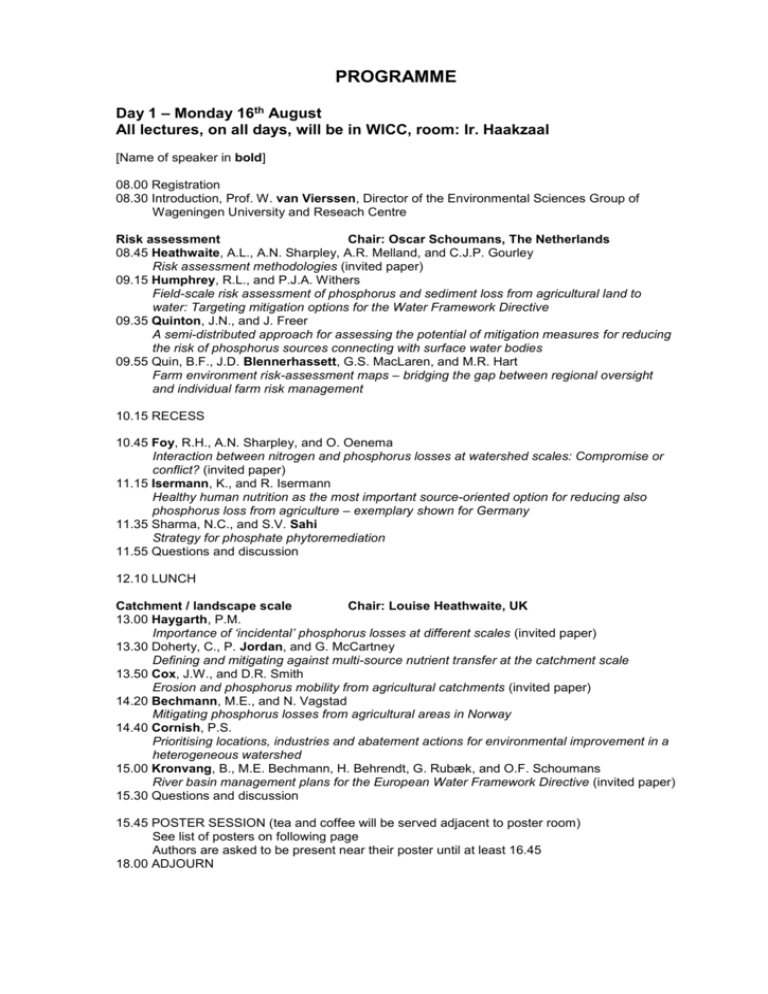
PROGRAMME Day 1 – Monday 16th August All lectures, on all days, will be in WICC, room: Ir. Haakzaal [Name of speaker in bold] 08.00 Registration 08.30 Introduction, Prof. W. van Vierssen, Director of the Environmental Sciences Group of Wageningen University and Reseach Centre Risk assessment Chair: Oscar Schoumans, The Netherlands 08.45 Heathwaite, A.L., A.N. Sharpley, A.R. Melland, and C.J.P. Gourley Risk assessment methodologies (invited paper) 09.15 Humphrey, R.L., and P.J.A. Withers Field-scale risk assessment of phosphorus and sediment loss from agricultural land to water: Targeting mitigation options for the Water Framework Directive 09.35 Quinton, J.N., and J. Freer A semi-distributed approach for assessing the potential of mitigation measures for reducing the risk of phosphorus sources connecting with surface water bodies 09.55 Quin, B.F., J.D. Blennerhassett, G.S. MacLaren, and M.R. Hart Farm environment risk-assessment maps – bridging the gap between regional oversight and individual farm risk management 10.15 RECESS 10.45 Foy, R.H., A.N. Sharpley, and O. Oenema Interaction between nitrogen and phosphorus losses at watershed scales: Compromise or conflict? (invited paper) 11.15 Isermann, K., and R. Isermann Healthy human nutrition as the most important source-oriented option for reducing also phosphorus loss from agriculture – exemplary shown for Germany 11.35 Sharma, N.C., and S.V. Sahi Strategy for phosphate phytoremediation 11.55 Questions and discussion 12.10 LUNCH Catchment / landscape scale Chair: Louise Heathwaite, UK 13.00 Haygarth, P.M. Importance of ‘incidental’ phosphorus losses at different scales (invited paper) 13.30 Doherty, C., P. Jordan, and G. McCartney Defining and mitigating against multi-source nutrient transfer at the catchment scale 13.50 Cox, J.W., and D.R. Smith Erosion and phosphorus mobility from agricultural catchments (invited paper) 14.20 Bechmann, M.E., and N. Vagstad Mitigating phosphorus losses from agricultural areas in Norway 14.40 Cornish, P.S. Prioritising locations, industries and abatement actions for environmental improvement in a heterogeneous watershed 15.00 Kronvang, B., M.E. Bechmann, H. Behrendt, G. Rubæk, and O.F. Schoumans River basin management plans for the European Water Framework Directive (invited paper) 15.30 Questions and discussion 15.45 POSTER SESSION (tea and coffee will be served adjacent to poster room) See list of posters on following page Authors are asked to be present near their poster until at least 16.45 18.00 ADJOURN List of poster papers (posters marked with * do not have an abstract in the proceedings) Blennerhassett, J.D., B.F. Quin, M.R. Hart, C.J. Watson, and A.C. Braithwaite Sulphur coating diammonium phosphate fertiliser to reduce incidental phosphorus losses to the surrounding environment * Borgvang, S.A., J.R. Selvik, and N. Vagstad The Euroharp project: a pan-European study on quantification of diffuse pollution sources and model applicability Demaria, P., E. Frossard, and S. Sinaj Relationships between phosphorus desorption and exchangeability in Swiss agricultural soils Ehlert, P.A.I., J.A. Nelemans, and W. van Tintelen Comparison of methods of determination of organic phosphorus in soils Geleta, S.B., C.H. Briand, H.E. Womack, R.B. Brinsfield, and F.R. Mulford Is phosphorous fertilization necessary for watermelon production on high phosphorous soils on Maryland’s Eastern Shore? Grant, R., G. Blicher-Mathiesen, and H.E. Andersen Leaching of dissolved phosphorus from Danish soils Gross, C.M., and J.L. Lemunyon Environmental risk assessment ... WITHDRAWN Hallissey, R., and W.L. Magette Developing and testing a phosphorus ranking scheme for Ireland Haygarth, P.M., M.J. Betson, P.J.A. Withers, R.A. Hodgkinson, D. Harris, and H. ApSimon Assessment of cost-effective phosphorus mitigation options relevant to UK agriculture He, Z., G.S. Toor, C.W. Honeycutt, and J.T. Sims Characterization of labile P forms in fresh dairy manure under mild assay conditions Kilroy, G., and C. Coxon Phosphorus and the water framework directive in the Shannon Pilot River Basin Koopmans,G.F., W.J. Chardon, and W.H. van Riemsdijk Phosphorus desorption dynamics in soil and the link to a dynamic concept of bioavailability * Kronvang, B., J.P. Jensen, T. Andersen, B. Arheimer, H. Behrendt, J. Hejzlar, and P. Boers Nutrient retention in surface water in 17 European catchments * Kronvang, B., S.E. Larsen, and H.E. Andersen Source apportionment of nutrient loads in 17 European catchments * Larsen, S.E., B. Kronvang, and H.E. Andersen Nutrient trends in 17 European catchments Mentler, A., B. Staudinger, and P. Strauss Determination of organic carbon (TOC), nitrogen (Nt) and phosphorus (Pt) in stable soil aggregates fractionated by ultrasound dispersion method Mullins, G.L., L.W. Zelazny, S.B. Phillips, M.R. Brosius, C.J. Penn, and C.E. Gala Surface runoff losses of phosphorus from selected Benchmark soils in Virginia that have been impacted by animal manure Salvia-Castellvi, M., J.F. Iffly, and L. Pfister Hydro-geological influences on P losses from rural catchments Sande Fouz, P., E. Vidal Vázque, and A. Paz González Phosphorus forms in overland water flow from a Galician agro forestry catchment Schärer, M., T. Page, and K. Beven Scale and uncertainty in modelling phosphorus transfer from agricultural catchments to watercourses * Schoumans, O.F., and M. Silgram Intercomparison of catchment-scale nutrient loss quantification methods Shober, A.L., and J.T. Sims Integrating source coefficients into risk assessments for phosphorus loss to water Sival, F.P., and W.J. Chardon Phosphate, a key factor for nature restoration on former arable land? Smith, D.R., E.A. Warnemuende, and C. Huang Treating ditch sediments to reduce downstream phosphorus delivery Staudinger, B. Particle P-loss in soil erosion - P distribution in stable soil aggregates after ultrasonic dispersion Ulén, B., and I. Rydberg Approaching background levels in water-borne phosphorus emissions from arable land. What can be achieved and how soon? Ylivainio, K., R. Uusitalo, and E. Turtola Manure-P fractionation - how does it predict P availability for plants and long-term effects on soil P? Day 2 – Tuesday 17th August Phosphorus in The Netherlands Chair: Oene Oenema, The Netherlands 08.30 Chardon, W.J., and G.F. Koopmans Phosphorus accumulation in Dutch soils: History, policies and options 09.00 van der Zee, S.E.A.T.M., W.J. Chardon, G.F. Koopmans, and O.F. Schoumans An indicator for phosphate saturation of soils 09.30 Schoumans, O.F., and R. van den Berg Evaluation of manure policy and its environmental impacts in The Netherlands 10.00 Mulleneers, E.A.J., and B.J.M. Crijns Phosphate regulation in the Dutch manure policy 10.20 RECESS 10.50 Hendriks, R.F.A., and C.L. van Beek Diffuse sources of phosphorus loading of surface waters in Dutch peat pasture areas 11.20 Verloop, J., H.F.M. Aarts, H. van Keulen, and J. Oenema Experiences with zero surplus P management and mining P on dairy farming system De Marke; strategies, effects on productivity and soil processes 11.50 Questions and discussion 12.05 LUNCH 13.15 EXCURSION By bus to National Park “De Hoge Veluwe” and the Kröller Müller Museum For more information see website: www.hogeveluwe.nl and www.kmm.nl. 13.45 Arrival in National Park, visit the Park and/or the Museum on a free bicycle 17.30 Depart to Wageningen (from the restaurant in the centre of the Park) 18.30 Conference Dinner in Restaurant “De Blauwe Kamer” 21.30 Depart of bus 1, back to hotels in Wageningen 22.00 Depart of bus 2 From websites: National Park De Hoge Veluwe is one of the Netherlands' oldest and largest national parks. It consists of no less than 5,500 hectares of woodland, heathland, lakes and driftsand. Together with the Kröller-Müller Museum and the sculpture garden it offers a unique combination of nature, art and architecture. De Hoge Veluwe is a park where visitors can still find plenty of space and peace, and where you can walk undisturbed for hours, or cycle using one of the free white bicycles. It is home to many endangered plant and animal species. Have you ever come face to face with a red deer, moufflon or roe deer? It can happen at De Hoge Veluwe! Alongside peace and space, there is also a lot to do in the Park. To protect the peacefulness, the activities are concentrated in the central area of the park. The Kröller-Müller Museum was designed by a Belgian architect, Henry van de Velde in 1937-38. Constructed in light brown brick, the design and layout is in line with Helene Kröller-Müller's ideas of bringing art and nature together so that each should enhance each other. The Kröller-Müller collection's main emphasis is on work of the late 19th and 20th centuries and its fame rests principally on its 280 paintings and drawings by van Gogh mainly from his stays in The Hague, Brabant, Paris, and Provence ("Bridge at Arles"). Other painters represented are George Serat, Pablo Picasso, Fernand Léger and Piet Mondriaan. The Kröller-Müller Museum has one of the largest sculpture gardens in Europe. The Sculpture Garden laid out in 1961 also reflects Helene Kröller-Müller's conception of a symbiosis between art, architecture and nature. It is filled with many modern pieces including Jacques Lipchitz, Claes Oldenburg, Henry Moore, Jean Debuffet, Auguste Rodin, and Barbara Hepworth. Day 3 – Wednesday 18th August (morning) Manure and Biosolids Chair: Tom Sims, USA 08.30 Jongbloed, A.W., and H. Valk Alteration of phosphorus content in diets for livestock: Impact on animal performance and health, and the environment (invited paper) 09.00 Maguire, R.O., B.C. Joern, Z. Dou, J.T. Sims, and J.T. Brake Phosphorus forms and mobility due to manipulating phosphorus in animal feed (invited paper) 09.30 Dao, Thanh H., J.B. Reeves, and H. Zhang Reducing the mobilization of organic phosphorus in dairy wastewaters: Chemistry and role of active and intermediate pools 09.50 He, Z., Z. Senwo, R. Mankolo, and C.W. Honeycutt Distribution of phosphorus species in poultry litter characterized by sequential fractionation coupled with phosphatase hydrolysis 10.10 Poulsen, H.D., C.D. Børgesen, G.H. Rubæk, G.J. Heckrath, J. Sehested, T. Dalgaard, J.F. Hansen, and A. Kyllingsbæk Scenarios for phosphorus accumulation in soil in relation to livestock intensity and feeding practice 10.30 RECESS 11.00 Dayton, E.A., and N.T. Basta Beneficial use of drinking water treatment residuals to protect surface water quality (invited paper) 11.30 Moore, P.A., Jr., D.R. Edwards, and T.C. Daniel Long-term effects of alum-treated poultry litter on soil chemistry, nutrient runoff and crop production: Is this treatment sustainable? 11.50 Staats, K.E., and D.L. Sparks Molecular-scale determination of P speciation in alum amended poultry litter 12.10 Sims, J.T., F.J. Coale, J. White, A.L. Shober, R.O. Maguire, and C.J. Penn Biosolids effects on phosphorus in soils and runoff: Environmental policy implications 12.30 Questions and discussion 12.45 LUNCH Day 3 – Wednesday 18th August (afternoon) Field issues / measurements Chair: Phil Haygarth, UK 13.45 Betson, M.J., E.I. Lord, and P.S. Davison; presented by R.L. Humphrey Modelling the effect of crop canopy development and associated management practice on erosion and phosphorus loss 14.05 Lundekvam, H.E. Effects of cultivation systems on P-losses through surface and drain runoff in south-eastern Norway 14.25 Shand, C.A., G. Coutts, J. Eubeler, and J.A. Chudek Redistribution of phosphorus in grazed ecosystems 14.45 Styles, D., I. Donohue, and C. Coxon Relating agronomic soil test P and soil type data to soluble P loss risk in Ireland: Implications of drying soil samples 15.05 Tujaka, A., and S. Gosek The effect of long-term fertilization on the migration and balance of phosphorus 15.25 RECESS 15.55 Tunney, H. Phosphorus and potassium concentrations in overland flow water from grassland plots 16.15 Watson, C.J., R.V. Smith, and E. Chisholm The effects of soil phosphorus status on phosphorus losses to surface runoff and land drainage water 16.35 Zhang, T.Q., C.F. Drury, C.S. Tan, W.D. Reynolds, and C. Fox Long-term changes in soil phosphorus forms and phosphorus losses in subsurface flow: Environmental evaluation of various cropping systems Costs / economics Chair: Phil Haygarth, UK 16.55 Annett, J.A., R.V. Smith, C. Jordan, W.G. Hutchinson, and C. Glass Costs and benefits of reducing phosphorus inputs to surface waters 17.15 Collentine, D. Phase-in of nonpoint sources in a Transferable Discharge Permit (TDP) system for water quality management 17.35 Questions and discussion 17.50 ADJOURN Day 4 – Thursday 19th August Please note the early start at 8 am! Catchment / landscape scale Chair: Marianne Bechmann, Norway 08.00 Kaffka, S.R. Managing phosphorus pollution at the landscape scale in the Upper Klamath Basin of Oregon and California 08.20 Andersson, L., B. Arheimer, M. Larsson, J. Olsson, C. Pers, J. Rosberg, K. Tonderski, and B. Ulén Integrated modelling of phosphorus fluxes at the catchment scale 08.40 Kronvang, B., C.C. Hoffmann, A. Laubel, I.K. Andersen, M.L. Pedersen, L.M. Svendsen, S.E. Larsen, and H.E. Andersen Revitalizing the natural phosphorus storage in river basins: Danish experiences from restoring lowland river and floodplains 09.00 Øygarden, L., and M.E. Bechmann Paired catchment comparison of measures to reduce phosphorus losses in Norway 09.20 Walker, F., and E. Bazen A GIS approach to identifying non-point source phosphorus pollution in an East Tennessee watershed 09.40 RECESS Surface water Chair: Lowie van Liere, The Netherlands 10.00 Braskerud, B.C., K. Tonderski, and B. Wedding A role for sedimentation ponds and constructed wetlands? (invited paper) 10.30 Boers, P.C.M., and L. van Liere Methods to abate eutrophication symptoms in lakes (invited paper) 11.00 Bakker, D., and J. de Klein Phosphorus retention in freshwaters in the Netherlands: Comparing a mass-balance and flow-path approach 11.20 Chambers, P.A., and M. Guy Defining the concentration of phosphorus causing impairment of a Canadian river 11.40 Lehtoranta, J., P. Ekholm, K. Lukkari, M. Leivuori, H. Pitkänen, and H. Hartikainen Phosphorus retention in an agriculturally loaded estuary 12.00 Meissner, R., H. Rupp, and P. Leinweber Impact of land use change and re-wetting on phosphorus concentration in surface water results and trends of a German case study 12.20 General discussion and conclusions 13.00 LUNCH 14.00 END OF WORKSHOP


